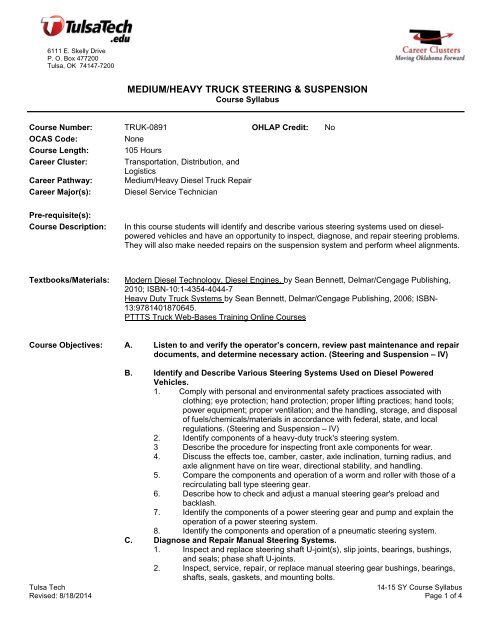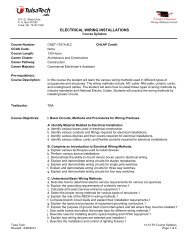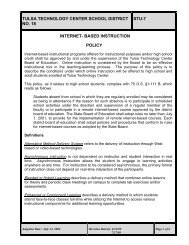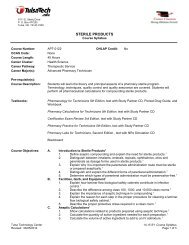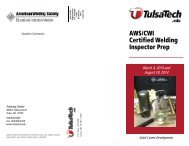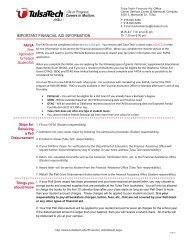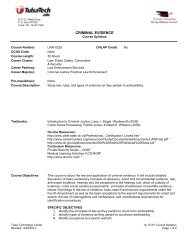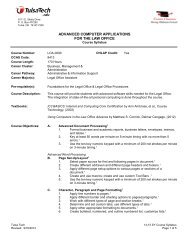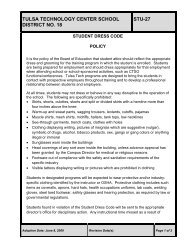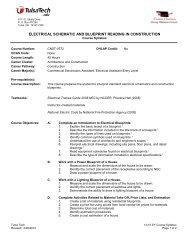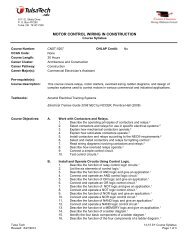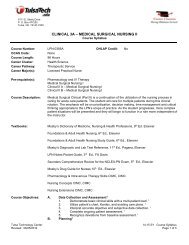MEDIUM/HEAVY TRUCK STEERING & SUSPENSION Course ...
MEDIUM/HEAVY TRUCK STEERING & SUSPENSION Course ...
MEDIUM/HEAVY TRUCK STEERING & SUSPENSION Course ...
Create successful ePaper yourself
Turn your PDF publications into a flip-book with our unique Google optimized e-Paper software.
6111 E. Skelly Drive<br />
P. O. Box 477200<br />
Tulsa, OK 74147-7200<br />
<strong>MEDIUM</strong>/<strong>HEAVY</strong> <strong>TRUCK</strong> <strong>STEERING</strong> & <strong>SUSPENSION</strong><br />
<strong>Course</strong> Syllabus<br />
<strong>Course</strong> Number: TRUK-0891 OHLAP Credit: No<br />
OCAS Code:<br />
None<br />
<strong>Course</strong> Length: 105 Hours<br />
Career Cluster: Transportation, Distribution, and<br />
Logistics<br />
Career Pathway: Medium/Heavy Diesel Truck Repair<br />
Career Major(s): Diesel Service Technician<br />
Pre-requisite(s):<br />
<strong>Course</strong> Description:<br />
In this course students will identify and describe various steering systems used on dieselpowered<br />
vehicles and have an opportunity to inspect, diagnose, and repair steering problems.<br />
They will also make needed repairs on the suspension system and perform wheel alignments.<br />
Textbooks/Materials:<br />
Modern Diesel Technology, Diesel Engines, by Sean Bennett, Delmar/Cengage Publishing,<br />
2010; ISBN-10:1-4354-4044-7<br />
Heavy Duty Truck Systems by Sean Bennett, Delmar/Cengage Publishing, 2006; ISBN-<br />
13:9781401870645.<br />
PTTTS Truck Web-Bases Training Online <strong>Course</strong>s<br />
<strong>Course</strong> Objectives: A. Listen to and verify the operator’s concern, review past maintenance and repair<br />
documents, and determine necessary action. (Steering and Suspension – IV)<br />
B. Identify and Describe Various Steering Systems Used on Diesel Powered<br />
Vehicles.<br />
1. Comply with personal and environmental safety practices associated with<br />
clothing; eye protection; hand protection; proper lifting practices; hand tools;<br />
power equipment; proper ventilation; and the handling, storage, and disposal<br />
of fuels/chemicals/materials in accordance with federal, state, and local<br />
regulations. (Steering and Suspension – IV)<br />
2. Identify components of a heavy-duty truck's steering system.<br />
3 Describe the procedure for inspecting front axle components for wear.<br />
4. Discuss the effects toe, camber, caster, axle inclination, turning radius, and<br />
axle alignment have on tire wear, directional stability, and handling.<br />
5. Compare the components and operation of a worm and roller with those of a<br />
recirculating ball type steering gear.<br />
6. Describe how to check and adjust a manual steering gear's preload and<br />
backlash.<br />
7. Identify the components of a power steering gear and pump and explain the<br />
operation of a power steering system.<br />
8. Identify the components and operation of a pneumatic steering system.<br />
C. Diagnose and Repair Manual Steering Systems.<br />
1. Inspect and replace steering shaft U-joint(s), slip joints, bearings, bushings,<br />
and seals; phase shaft U-joints.<br />
2. Inspect, service, repair, or replace manual steering gear bushings, bearings,<br />
shafts, seals, gaskets, and mounting bolts.<br />
Tulsa Tech<br />
14-15 SY <strong>Course</strong> Syllabus<br />
Revised: 8/18/2014 Page 1 of 4
<strong>MEDIUM</strong>/<strong>HEAVY</strong> <strong>TRUCK</strong> <strong>STEERING</strong> & <strong>SUSPENSION</strong><br />
D. Diagnose and Repair Power Steering Systems.<br />
1. Diagnose fixed and driver adjustable steering column and shaft noise,<br />
looseness, and binding proems; determine needed action. (P1-IV.A.1.1)<br />
2. Inspect steering shaft U-joint(s), slip joints, bearings, bushings, and seals;<br />
phase shaft U-joints; determine needed action. (P1-IV.A.1.2)<br />
3. Diagnose power steering system noise, steering binding, darting/oversteer,<br />
reduced wheelcut, steering wheel kick, pulling, non-recovery, turning effort,<br />
looseness, hard steering, overheating, fluid leakage, and fluid aeration<br />
problems; determine needed action. (P1-IV.A.2.1)<br />
4. Determine recommended type of power steering fluid; check level and<br />
condition; determine needed action. (P1-IV.A.2.2)<br />
5. Flush and refill power steering system; purge air from system. (P2-IV.A.2.3)<br />
6. Perform power steering system pressure, temperature, and flow tests;<br />
determine needed action. (P2-IV.A.2.4)<br />
7. Inspect, service, or replace power steering reservoir including filter, seals, and<br />
gaskets. (P2-IV.A.2.5)<br />
8. Inspect and reinstall/replace pulleys, tensioners and drive belts; adjust drive<br />
belts and check alignment. (P1-IV.A.2.6)<br />
9. Inspect, replace as required, power steering pump drive gear and coupling.<br />
(P3-IV.A.2.7)<br />
10. Inspect, adjust, or replace power steering pump, mountings, and brackets.<br />
(P3-IV.A.2.8)<br />
11. Inspect and replace power steering system cooler, lines, hoses,<br />
clamps/mountings, hose routings, and fittings. (P3-IV.A.2.9)<br />
12. Inspect, adjust, or replace linkage-assist type power steering cylinder or gear<br />
(dual system). (P3-IV.A.2.10)<br />
13. Inspect, adjust, repair, or replace integral type power steering gear and<br />
mountings. (P1-IV.A.2.11)<br />
14 Adjust manual and automatic steering gear poppet/relief valves. (P2-IV.A.2.12)<br />
15. Inspect power steering gear, seals, and gaskets; replace as needed.<br />
16 Check and adjust cab mounting ride height. (P3-IV.A.1.3)<br />
17 Center the steering wheel as needed. (P1-IV.A.1.4)<br />
18. Disable and enable supplemental restraint system (SRS) in accordance with<br />
manufacturers’ procedures. (P2-IV.A.1.5)<br />
E. Inspect and Service Steering Linkages.<br />
1. Inspect and align pitman arm; replace as needed. (P1-IV.A.3.1)<br />
2. Inspect, drag link (relay rod)and tie rod ends; adjust or replace as needed. (P1-IV.A.3.2)<br />
3. Inspect and replace idler arm, bearings, and bushings.<br />
4. Inspect steering arm and levers, and linkage pivot joints; replace as needed.<br />
(P1-IV.A.3.3)<br />
5. Inspect clamps and retainers on cross tube/relay rod/centerlink/tie rod; position<br />
or replace as needed. (P1-IV.A.3.4)<br />
6. Check and adjust wheel stops. (P1-IV.A.3.5)<br />
7. Lubricate steering linkage joints as needed. (P1-IV.A.3.6)<br />
F. Inspect, Diagnose and Repair Suspension System.<br />
1. Listen to and verify operator’s concern; review past maintenance and repair<br />
documents; determine necessary action (Steering and Suspension - IV)<br />
2. Identify types of suspension systems used on today's heavy-duty trucks.<br />
3. Match basic components of various suspension systems with their functions.<br />
4. Troubleshoot suspension system components to isolate and locate defects.<br />
5. Explain the relationship between axle alignment and suspension system<br />
alignment.<br />
Tulsa Tech<br />
14-15 SY <strong>Course</strong> Syllabus<br />
Revised: 8/18/2014 Page 2 of 4
<strong>MEDIUM</strong>/<strong>HEAVY</strong> <strong>TRUCK</strong> <strong>STEERING</strong> & <strong>SUSPENSION</strong><br />
6. Diagnose rough ride problems.<br />
7. Inspect front axles, U-bolts, and nuts; determine needed action. (P1-IV.B.1)<br />
8. Inspect and service king pin, steering knuckle bushings, locks, bearings, seals,<br />
and covers; determine needed action. (P1-IV.B.2)<br />
9. Inspect shock absorbers, bushings, brackets, and mounts; replace as needed.<br />
(P1-IV.B.3)<br />
10. Inspect leaf springs, center bolts, clips, eye bolts and bushings, shackles,<br />
slippers, insulators, brackets, and mounts; determine needed action. (P1-<br />
IV.B.4)<br />
11. Inspect and service torsion bars, bell cranks, ratchets, bushings, bearings, and<br />
mounting brackets; determine needed repairs.<br />
12. Inspect torque arms, bushings and mounts; determine needed action. (P1-<br />
IV.B.5)<br />
13. Inspect axle aligning devices such as radius rods, track bars, stabilizer bars,<br />
and related bushings, mounts, shims, and cams; determine needed action.<br />
(P1-IV.B.6)<br />
14. Inspect walking beams, center (cross) tube, bushings, mounts, load pads, and<br />
saddles/caps; replace as needed. (P3-IV.B.7)<br />
15. Inspect and test air suspension pressure regulator and height control valves,<br />
lines, hoses, dump valves, and fittings; adjust, repair or replace as needed.<br />
(P1-IV.B.8)<br />
16. Inspect and test air springs, mounting plates, springs, suspension arms and<br />
bushings; replace as needed. (P1-IV.B.9)<br />
17. Measure vehicle ride height; determine needed action. (P1-IV.B.10)<br />
18. Diagnose rough ride problems; determine needed action. (P3-IV.B.11)<br />
G. Perform Wheel Alignment.<br />
1. Diagnose vehicle wandering, pulling, shimmy, hard steering, and off-center<br />
steering wheel problem(s); adjust and repair as needed. (P1-IV.C.1)<br />
2. Check camber; determine needed action. (P2-IV.C.2)<br />
3. Check caster; adjust as needed. (P2-IV.C.3)<br />
4. Check toe; adjust as needed. (P1-IV.C.4)<br />
5. Check rear axle(s) alignment (thrustline/centerline) and tracking; adjust or<br />
repair as needed. (P2-IV.C.5)<br />
6. Diagnose turning/Ackerman angle (toe-out-on-turns) problems; determine<br />
needed action. (P3-IV.C.6)<br />
7. Check front axle alignment (centerline); adjust or repair as needed. (P2-IV.C.7)<br />
1<br />
ODCTE Objective<br />
Coding indicates NATEF alignment.<br />
All unmarked objectives are TTC instructor developed.<br />
Teaching Methods:<br />
The class will primarily be taught by the lecture and demonstration method and supported by<br />
various media materials to address various learning styles. There will be question and answer<br />
sessions over material covered in lecture and media presentations. Supervised lab time is<br />
provided for students to complete required projects.<br />
Tulsa Tech<br />
14-15 SY <strong>Course</strong> Syllabus<br />
Revised: 8/18/2014 Page 3 of 4
<strong>MEDIUM</strong>/<strong>HEAVY</strong> <strong>TRUCK</strong> <strong>STEERING</strong> & <strong>SUSPENSION</strong><br />
Grading Procedures:<br />
1. Students are graded on theory and shop practice and performance.<br />
2. Each course must be passed with seventy (70%) percent or better.<br />
3. Grading scale: A=90-100%, B=80-89%, C=70-79%, D=60-69%, F=50-59%.<br />
Description of<br />
Classroom,<br />
Laboratories, and<br />
Equipment:<br />
Tulsa Technology Center campuses are owned and operated by Tulsa Technology Center<br />
School District No. 18. All programs provide students the opportunity to work with<br />
professionally certified instructors in modern, well-equipped facilities.<br />
Available<br />
Certifications/<br />
College Credit<br />
The student may be eligible to take state, national or industry exam after completion of the<br />
program. College credit may be issued from Oklahoma State University-Okmulgee or Tulsa<br />
Community College. See program counselor for additional information.<br />
College Credit<br />
Eligibility:<br />
The student must maintain a grade point average of 2.0 or better.<br />
Tulsa Tech<br />
14-15 SY <strong>Course</strong> Syllabus<br />
Revised: 8/18/2014 Page 4 of 4


